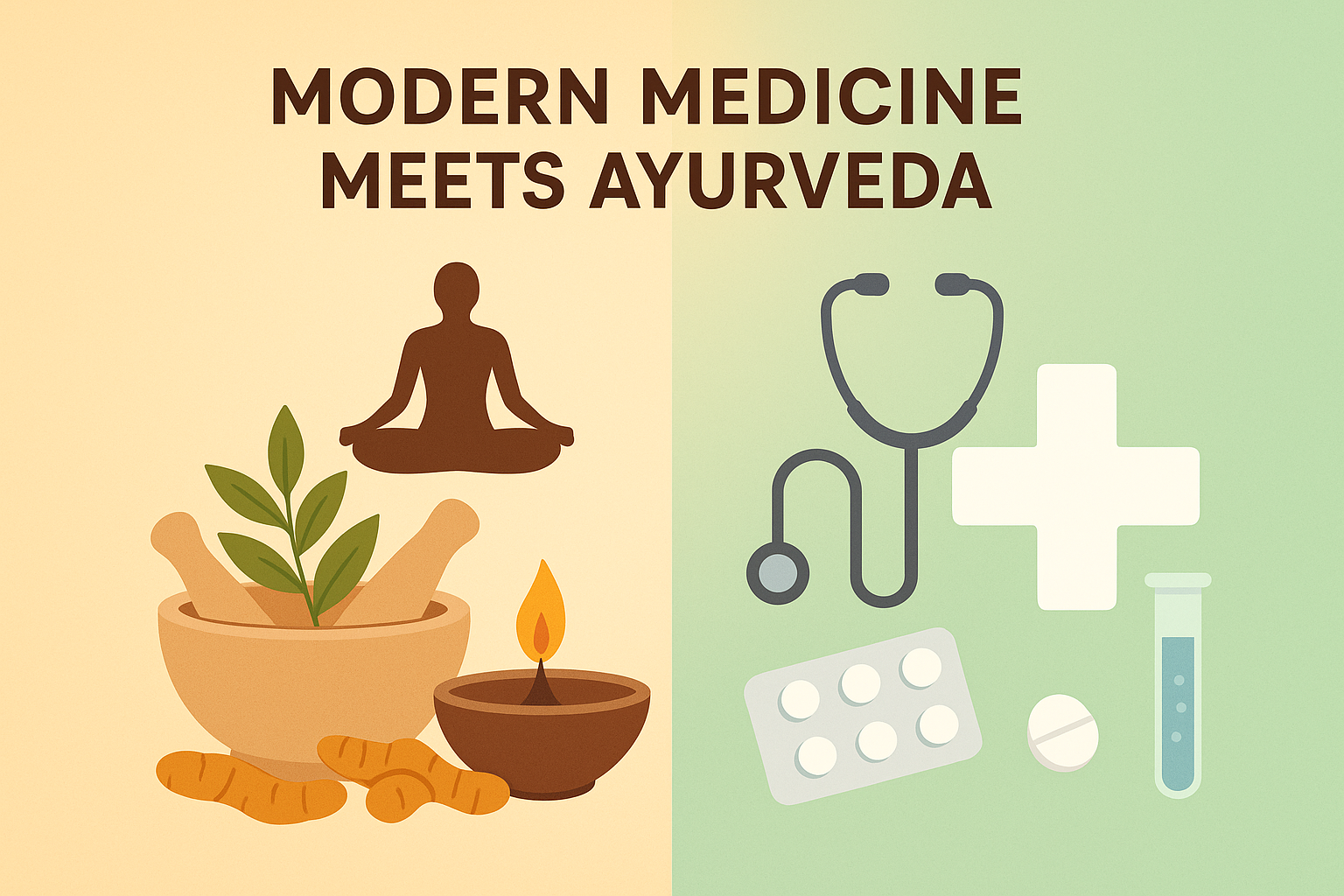Subtotal $0.00
Ayurveda, the age-old science of life, and modern medicine, which depends on tests, medications, and operations, have long coexisted in India. Patients frequently felt compelled to “choose one” for years. Since both systems can cooperate, there’s really no reason to choose at all.
Integrative care can help with that. In order to provide patients with comprehensive, safer, and more efficient treatment plans, an increasing number of clinics in India are combining Ayurveda with contemporary medicine. And the difference is being noticed by the patients.
What Exactly Is Integrative Medicine?
Consider it similar to teamwork. For infections, emergencies, or accurate diagnosis, modern medicine is great. Conversely, Ayurveda examines the underlying cause, including your daily routine (Dinacharya), diet, lifestyle, and even seasonal variations (Ritucharya).
Together, you create long-term health rather than merely “treating a symptom.” For instance:
- A modern doctor gives prescriptions and checks blood sugar levels.
- For stress relief, an ayurvedic physician incorporates yoga, triphala, and gudmar as herbal remedies.
- Together, they develop a strategy that strikes a balance between prevention and safety.
The outcome? Patients experience long-term, not just short-term, improvements.

How Integration Operates in Actual Clinics
Suppose a patient with type 2 diabetes shows up. In an integrative setup, the following occurs:
- Diagnostics: contemporary medicine’s blood sugar monitoring, screenings, and emergency care.
- Ayurvedic consultation: diet, herbal remedies, and lifestyle modifications..
- Therapy balance: regular evaluations by both physicians to ensure that herbs and medications don’t conflict.
- Support care includes stress reduction, yoga, meditation, and Panchakarma for detoxification.
Patients frequently report feeling more invigorated, having less of a need for large doses, and having more stable blood sugar levels. It’s synergy, not magic.
Advantages of Integrating Modern Medicine with Ayurveda
- Ayurveda treats the underlying causes, while modern care intervenes during flare-ups. This approach is holistic and preventive.
- improved control of long-term conditions like diabetes, gastrointestinal problems, and arthritis.
- Decreased adverse effects: herbal assistance can lessen the severity of chronic medications..
- Personalised treatment: There is no “one-size-fits-all” approach in Ayurveda’s Prakriti concept.
- Quicker recuperation and rehabilitation: In addition to traditional rehabilitation, yoga and Panchakarma frequently aid patients in recovering more quickly.
(Bold truth: when doctors work together instead of competing, patients are happier.)
Regulation, Safety, and Guidelines
“Is combining Ayurveda and allopathy safe?” The answer to this frequently asked question is: Yes, provided it is done properly.
- Don’t rely solely on Google; always consult both doctors..
- Co-located clinics, where both systems operate under one roof, are actively promoted by the AYUSH ministry of the Government of India.
- Successful integrative models are already being implemented at prestigious hospitals like AIIMS, Tata Memorial, and AIIA.
Who Needs to Think About Integrative Wellness?
- people who are in charge of long-term illnesses like IBS, diabetes, or arthritis.
- Anyone sick of long-term drug side effects?
- those interested in preventive health who prefer a lifestyle-based strategy
- After undergoing extensive treatments, patients seek rehabilitation assistance.
Actual Patient Experience
One patient (let’s call her Shalini) reported that she was able to cut her pain medication use in half in just six months after enrolling in an integrative clinic for her arthritis. Her joints benefited from the Ayurvedic oil treatments and yoga, and flare-ups were controlled by contemporary medicine.
“It felt like both doctors were finally on my side instead of pulling me in different directions,” she remarked.
Beginning Integrative Care
- Seek out accredited clinics with specialists in both allopathy and Ayurveda.
- Ask about herb-drug safety procedures, read reviews, and look at patient endorsements.
- You should anticipate both a lifestyle consultation and a diagnostic examination on your initial visit.
Final words
Selecting modern medicine or Ayurveda is not the goal of integrative care. It comes down to selecting health. Patients receive wellness, prevention, and hope for long-term healing in addition to treatment when the knowledge of Ayurveda and the accuracy of contemporary science are combined.
Perhaps it’s time to look into an integrative consultation if you’re thinking about it. Your body will appreciate it.

